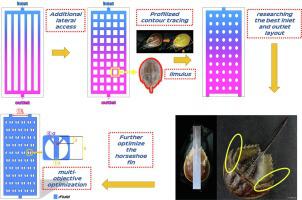Applied Thermal Engineering ( IF 6.1 ) Pub Date : 2023-09-16 , DOI: 10.1016/j.applthermaleng.2023.121597 Furen Zhang , Zhikai Huang , Shiyuan Li , Shizheng Sun , Haibo Zhao

|
As the current channel-type liquid cooling plate generally suffer from high pressure loss and low cooling efficiency, making electric vehicles have to face problems such as high battery pack temperature and short mileage. To solve the above problems with channelized liquid-cooled plate, the conventional liquid-cooled channel was first rectangularly finned, and the size of the fins was optimized by varying the longitudinal spacing ratio f/a and transverse spacing ratio w/b between adjacent fins. Results show that the liquid-cooled plate had the lowest average temperature and pressure drop and the best overall performance when the size of the fins in the corresponding directions and the size of the spacing between the corresponding directions were equal. Secondly, on the basis of the optimization, the preferred fin form was preliminarily biomimetic. CFD simulation results show that the bionic limulus-like fins (BLLF) were more effective, with pressure drop (ΔP) and average temperature (T_ave) improved to a certain extent, compared with the rectangular and oval conventional shape fins. Subsequently, the number of inlets and outlets and their layout positions were discussed. Then, in order to further improve the performance of the cold plate, according to the shape characteristics of the limulus, the scrambler fins were homogenized to form a central channel and two secondary channels were added diagonally upward, which continued to construct a new type of microfin for the bionic limulus, and a multi-objective optimization of the secondary channels was carried out with L, W, α, and β as the parameters. Compared with the original model, T_ave and ΔP of the optimal model were reduced by 1.69 °C (4.61 %) and 6.81 Pa (54.26 %). Finally, the effect of the variation of Reynolds number on the thermal performance was discussed. It can be seen that the bionic fin design approach obtained in this study will provide a reference for liquid-cooled channel finning optimization.
中文翻译:

基于液冷通道翅片和仿生鲎鳍片的新型微翅片液冷板设计及热性能分析
由于目前的通道式液冷板普遍存在压力损失大、冷却效率低的问题,使得电动汽车不得不面临电池组温度高、续航里程短等问题。为了解决通道化液冷板的上述问题,首先将常规液冷通道制成矩形翅片,通过改变相邻翅片之间的纵向间距比f/a和横向间距比w/b来优化翅片尺寸。结果表明,当相应方向翅片尺寸和相应方向间距尺寸相等时,液冷板的平均温度和压降最低,综合性能最好。其次,在优化的基础上,初步仿生优选的鳍片形式。CFD模拟结果表明,与矩形和椭圆形传统形状翅片相比,仿生鲎类翅片(BLLF)的效果更加明显,压降(ΔP)和平均温度(T_ave )都有一定程度的改善。随后,讨论了入口和出口的数量及其布置位置。然后,为了进一步提高冷板的性能,根据鲎的外形特点,将扰流翅片均质化,形成一个中央通道,并斜向上增加两个二级通道,继续构造了一种新型的冷板。以仿生鲎为微鳍,以L、W、α、β为参数对次通道进行多目标优化。与原模型相比,优化模型的T_ave和ΔP分别降低了1.69℃(4.61%)和6.81Pa(54.26%)。最后讨论了雷诺数的变化对热性能的影响。可见,本研究获得的仿生翅片设计方法将为液冷通道翅片优化提供参考。































 京公网安备 11010802027423号
京公网安备 11010802027423号